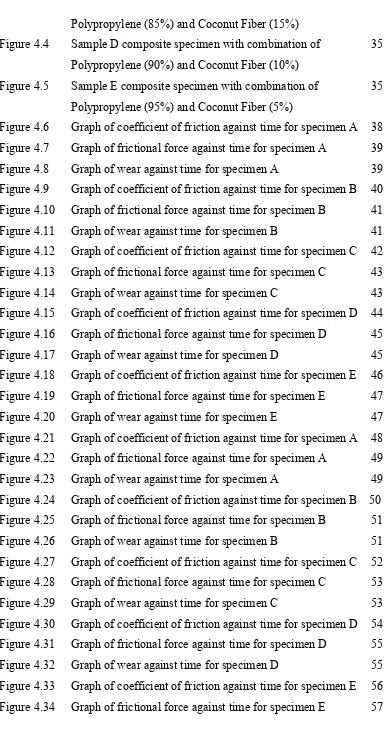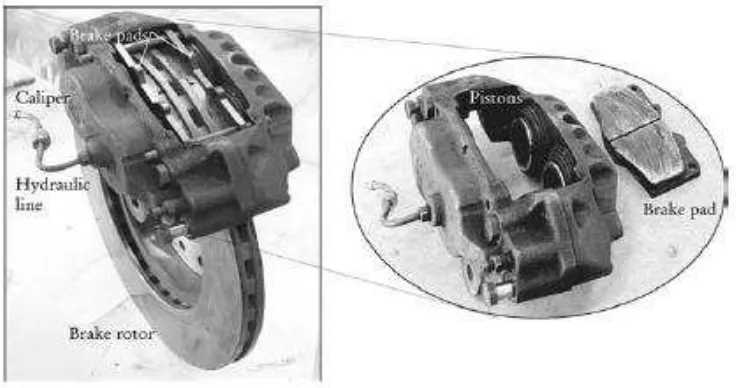A STUDY ON THE EFFECT OF COCONUT FIBER TO POLYPROPYLENE (PP) AS A FRICTION MATERIAL
MOHD ADNAN HAFIZ BIN ZAHARI
SUPERVISOR DECLARATION
“I hereby declare that I have read this thesis and in my opinion this report is sufficient in terms of scope and quality for the award of the degree of
Bachelor of Mechanical Engineering (Structure & Material)”
Signature: ...
Supervisor: ...
A STUDY ON THE EFFECT OF COCONUT FIBER TO POLYPROPYLENE
(PP) AS A FRICTION MATERIAL
MOHD ADNAN HAFIZ BIN ZAHARI
This report is submitted in partial of requirement for the Bachelor Degree of
Mechanical Engineering ( Structure & Material )
Fakulti Kejuruteraan Mekanikal
Universiti Teknikal Malaysia Melaka
DECLARATION
“I hereby declare that the work in this report is my own except for summaries and quotations which have been duly acknowledged.”
Signature: ...
Author: ...
ACKNOWLEDGEMENT
ABSTRACT
ABSTRAK
TABLE OF CONTENT
CHAPTER TOPIC PAGE
DECLARATION ii
ACKNOWLEDGEMENT iii
ABSTRACT iv
ABSTRAK v
LIST OF TABLES ix
LIST OF FIGURES x
LIST OF SYMBOLS xiii
LIST OF ABBREVIATION xiv
LIST OF APPENDIX xv
CHAPTER 1 1
INTRODUCTION 1
1.1. Background 1
1.2. Objective 3 1.3. Problem Statement 3
CHAPTER 2 4
LITERATURE REVIEW 4
2.1. Friction Material 4
2.2. Composite 5
2.2.1. Reinforcements 7
2.2.2. Matrix Materials 8
2.3. Friction and Wear of Friction Material 9
2.4. Coconut Fiber 10
2.4.1. Chemical Properties 12
2.4.2. Physical and Mechanical Properties 13
2.5. Polypropylene (PP) 15
2.5.1. Characteristic of Polypropylene (PP) 16 2.5.2. Mechanical and Thermal Properties 17
CHAPTER 3 19
METHODOLOGY 19
3.1. Introduction 19
3.2. Raw Materials Preparation 21
3.2.1. Coconut Fiber 21
3.2.2. Polypropylene (PP) 22
3.3. Fabrication 22
3.3.1 Preparation of Polypropylene (PP) Process 23
3.3.2 Hot Press Process 25
3.3.2.1 Procedure 27
3.4. Testing and Analysis 27
3.4.1 Density of Composite Materials 28
3.4.2 Hardness Test 29
3.4.3 Friction and Wear Test 30
3.4.3.1 Friction and Wear Test Specimen 31
3.4.3.2 Procedure 31
CHAPTER 4 33
RESULT 33
4.1 Specimens 33
4.2 Mechanical Properties Result 36
4.3 Tribological Properties Result 37 4.3.1 Friction and Wear of Fixed Load 10 kg 38 4.3.2 Friction and Wear of Fixed Load 20 kg 48
4.4 Morphology Surface Result 58
CHAPTER 5 61
DISCUSSION AND ANALYSIS 61
5.1 Analysis of Mechanical Properties Result 61 5.2 Analysis of Tribological Properties Result 63 5.3 Analysis of Morphology Surface Result 67
CHAPTER 6
CONCLUSION AND RECOMMENDATION 70
6.0 Conclusion 70
6.1 Recommendations 70
REFERENCES 72
LIST OF TABLES
NUM. TITLE PAGE
LIST OF FIGURES
NUM. TITLE PAGE
Figure 2.1 Friction materials inside the braking system (brake pad) 5 Figure 2.2 Friction materials inside the clutch system 5
Figure 2.3 Coconut fiber 11
Figure 2.4 The Physical Structure of Coconut Fruits 11 Figure 2.5 Mean Stress-Strain Curves for Coconut Fibers 13 Figure 2.6 Stress-Strain Curves of Natural Fibers 14 Figure 2.7 Polypropylene (PP) Chain Structure 15 Figure 3.1 Schematic flow chart diagram of manufacturing process 20
Figure 3.2 Coconut Fiber 21
Figure 3.3 Polypropylene (PP) 22
Figure 3.4 Polypropylene (PP) plate 24
Figure 3.5 Crusher Machine 24
Figure 3.6 Stainless steel blender 24
Figure 3.7 Deformation of polypropylene (PP) 25 Figure 3.8 Hot Isostatic Press Machine 26 Figure 3.9 Components of Hot Press Machine 26
Figure 3.10 Pin Cylinder Mold 27
Figure 3.11 Electronic Densitometer Machine 29
Figure 3.12 Shore Hardness Tester 29
Figure 3.13 Pin-on-Disk Machine 30
Figure 3.14 CCD Microscope 32
Figure 4.1 Sample A composite specimen with combination of 33 Polypropylene (75%) and Coconut Fiber (25%)
Figure 4.2 Sample B composite specimen with combination of 34 Polypropylene (80%) and Coconut Fiber (20%)
Polypropylene (85%) and Coconut Fiber (15%)
Figure 4.4 Sample D composite specimen with combination of 35 Polypropylene (90%) and Coconut Fiber (10%)
Figure 4.5 Sample E composite specimen with combination of 35 Polypropylene (95%) and Coconut Fiber (5%)
Figure 4.35 Graph of wear against time for specimen E 57 Figure 4.36 Morphological effect on specimen A surface after were 58
applied loadof 20 kg
Figure 4.37 Morphological effect on specimen B surface after were 59 applied load of 20 kg
Figure 4.38 Morphological effect on specimen C surface after were 59 applied load of 20 kg
Figure 4.39 Morphological effect on specimen D surface after were 60 applied load of 20 kg
Figure 4.40 Morphological effect on specimen E surface after were 60 applied load of 20 kg
Figure 5.1 External structure of specimen A 62 Figure 5.2 Comparison of graph (a) Coefficient of friction against 64
time; (b) Frictional force against time
Figure 5.3 Comparison of graph (a) Coefficient of friction against 65 time; (b) Wear against time
Figure 5.4 Irregular shape graph of specimen A 66 Figure 5.5 Wear effect on the specimen surface before friction and 67
wear test
Figure 5.6 Wear effect on the specimen surface after friction and 68 wear test
LIST OF SYMBOLS
F = Force, N
μ = Coefficient of friction
N = Normal force, N
� = Density of composite material, g/cm3
� = Weight of the specimen when hung in the air, kg
�� = Weight of the partly immersed wire holding the specimen, kg �� ��� = Density of the distilled water at testing temperature, g/cm3
� = Weight of the specimen when immersed fully in distilled water, along with the partly immersed wire holding the specimen, kg
LIST OF ABBREVIATION
NUM. TITLE
PP Polypropylene PE Polyethylene PS Polystyrene
PA Polyamide
PVC Polyvinylchloride
PMC Polymer Matrix Composite FRP Fiber-Reinforced Plastic PEEK Polyetheretherketone PPS Polyphenylene Sulfide
LIST OF APPENDIX
NUM. TITLE PAGE
CHAPTER 1
INTRODUCTION
1.1 Background
Nowadays, friction materials play an important role in industries especially for automotive, aircraft and aerospace, railroad and heavy machine manufacturing. Friction material can be categorizes as a diverse material which is made up from few elements and each element has its own function. Theoretically, friction materials are used in system that requires specific contact influence between two or more parts. Typical example for friction materials are brake and clutch system, transmissions, and certain household items. Earlier researchers have concluded that there is no simple correlation between friction and wear properties of a friction material with the physical and mechanical properties (Tanaka et al. 1973). Therefore, each new
formulation developed needs to be subjected to a series of test to evaluate its friction and wear properties using brake dynamometer as well as on-road braking performance test to ensure that the brake friction material developed will comply with the minimum requirements of its intended application. The need for effective friction materials is so great that the market for friction products is nearly seven billion dollars per year (Chan and Stachowiak, 2004).
Friction materials are heterogeneous materials and are composed of a few elements. Each element has its own function such as to improve friction property at low and high temperature, increase strength and rigidity, prolong life, reduce porosity and reduce noise. Changes in element types or weight percentage of the elements in the formulation may change the physical, mechanical and chemical properties of the brake friction materials to be developed (Jaafar et al. 2012). Some
advanced fibers and different metal alloys. Common usage, asbestos was actually widely used as a friction material until its usage was banned (Chan and Stachowiak, 2004). The proper selection of friction materials depends on the application, namely the speeds encountered, the temperatures involved and the performance requirements. The ideal friction materials should possess various desirable properties such as resistance to heat, water and oil, has low water rate, high thermal stability and exhibits low noise. However, it is practically impossible to have all these desired properties. Therefore, some requirements have to be compromised in order to achieve some other requirements.
In general, each formulation of friction material has its own unique frictional behaviors and wear-resistance characteristics. For example, sintered metal materials are well-suited to heavy duty applications, like aircraft braking system and industrial machinery clutches. Differently, paper is used as a friction material in many automobiles and light trucks, although the “paper” used in these system is not the paper that we used in daily life. It consists of a cotton or cellulose fiber and phenolic resin mixture, which is later bonded to a steel backing plate (Lu, 2006). Friction materials used for clutches and brakes are attached to more standard components made from cast iron and other similar materials. Like paper friction materials, these clutch and brake friction providers are commonly made of woven, molded or sintered materials composed of a diverse range of substances including fibers, metal particles and bonding materials.
1.2 Objective
The overall aims of this study are:
1) To study the effect of coconut fiber on mechanical properties of polypropylene (PP)
2) To study the effect of coconut fiber on tribological properties of polypropylene (PP)
1.3 Problem Statement
Nowadays, friction materials are very important in engineering field especially in aircraft and aerospace, automotive, railroad, heavy machine manufacturing and defense industry. Friction materials require a friction stability, durability and minimization of noise. Generally, friction materials consist of several materials blended with polymer to improve its tribological properties. Polypropylene (PP) is a material typically used for high temperature application. Since friction materials deal with high temperature operation, polypropylene (PP) application as friction materials is considered fit to the tribological application.
1.4 Scope
Based on the objectives mentioned above, the study is focusing to be more specific, in order to give a clearer view on the crucial points. This research is focusing in study the effect of coconut fiber to mechanical and tribological properties of polypropylene (PP). However, effect of fiber orientation is beyond this project. The scopes including in this study are:
1) Literature study
2) Manufacturing the sample, starting from mixing the polymers to shape the specimen
3) Analysis of mechanical and tribological properties of polypropylene (PP) in the presence of the fiber
CHAPTER 2
LITERATURE REVIEW
2.1 Friction Material
Figure 2.1: Friction material inside the braking system (brake pad) (Source: Chan and Stachowiak, (2004))
Figure 2.2: Friction material inside the clutch system (Source: Chan and Stachowiak, (2004))
2.2 Composite
used in a wide range of industrial applications like aeronautic, naval, construction, sporting goods, home appliances and furniture. They have been on the market for over fifty years, and have generally been used to replace materials such as wood, aluminum and steel. Their advantages over traditional materials include greater mechanical strength, lighter weight, better dimensional stability, higher dielectric strength and corrosion resistance, and flexibility to improve the design (Etcheverry and Barbosa, 2012). The major advantage of these composites that help them enter into such a variety of markets is their high specific property, which is greater than that of metals and ceramics. Despite that, the perfect well-bonded interphases between the matrix and reinforcement remain as a critical issue in this kind of material. This factor is critical with thermoplastic material such as polyethylene (PE), polypropylene (PP), polystyrene (PS), polyamide (PA) and polyvinylchloride (PVC). With advantages of many times better performance compared to all materials, composite materials have the potential to replace steel and aluminum which is widely used nowadays. Replacing steel components with composite components can save 60 to 80% in component weight, and 20 to 50% weight by replacing aluminum parts (Mazumdar 2001).

